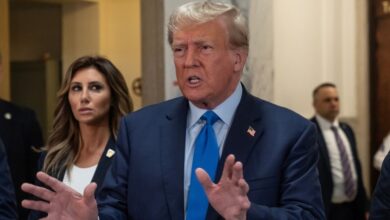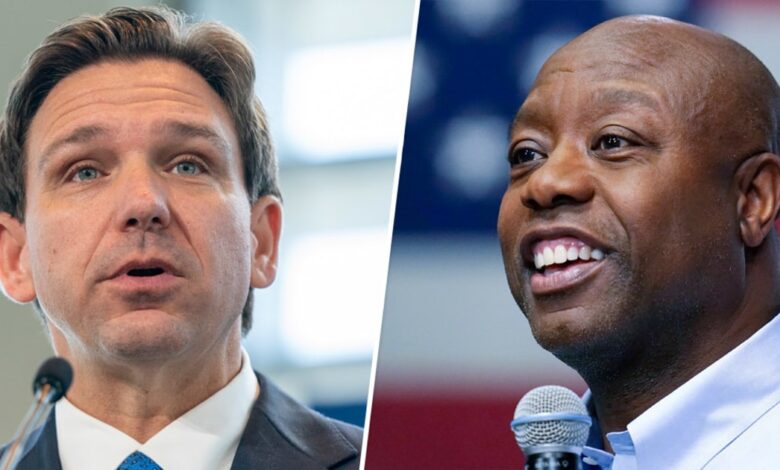
Desantis Trump Republicans Primaries Showdown
Desantis Trump Republicans Primaries: a potential showdown is brewing as the Republican field heats up for the 2024 Presidential race. The rivalry between DeSantis and Trump, two prominent figures in American politics, promises an intense primary battle. This analysis dives deep into the strategies, policy differences, and potential impact of this crucial election.
The upcoming Republican primaries are more than just a contest for the nomination; they are a reflection of the current political climate and a potential harbinger of the future direction of the Republican party. The candidates’ backgrounds, campaign strategies, and policy stances will all play a significant role in shaping the outcome and the narrative that will unfold in the months to come.
DeSantis and Trump’s 2024 Presidential Candidacy
The 2024 Republican presidential primary is shaping up to be a fiercely contested battleground, with Florida Governor Ron DeSantis and former President Donald Trump as the leading contenders. Their relationship, marked by both cooperation and confrontation, is a significant factor influencing the primary race and the broader political landscape. The candidates are vying for the support of Republican voters, and their strategies, policy platforms, and personal backgrounds are crucial elements in understanding the potential outcome of the election.The dynamic between DeSantis and Trump is complex and has evolved over time.
Initially, DeSantis was seen as a rising star within the Republican Party, and Trump’s endorsement would have been crucial for his success. However, their relationship has become increasingly strained as DeSantis’s ambitions have grown and their policy differences have emerged. This evolving dynamic has significantly impacted the political landscape of the Republican party.
Relationship and Public Statements
The relationship between DeSantis and Trump has been marked by a mix of public endorsements and behind-the-scenes tension. Trump initially endorsed DeSantis for governor in 2018, but their relationship has cooled since. Public statements from both candidates reveal their differing approaches to policy and political strategy. Trump’s frequent criticisms of DeSantis, often centered around perceived policy differences and political maneuvering, have created an environment of competition within the Republican Party.
DeSantis, in turn, has carefully crafted his own public persona, positioning himself as a viable alternative to Trump, emphasizing his policy distinctions.
The DeSantis-Trump Republican primaries are heating up, with candidates vying for the nomination. Meanwhile, the recent embezzlement scandal at the Eugene Weekly, detailed in this report on Eugene Weekly embezzlement printing , highlights the potential for financial irregularities in even seemingly small-scale operations. This certainly doesn’t seem to be helping the Republican image, as the primary race continues to gain national attention.
Strategies in the Republican Primaries
Both candidates are likely employing distinct strategies to garner support in the Republican primaries. Trump, leveraging his established base of support and experience in the political arena, is likely to emphasize his achievements as president and his perceived ability to deliver on key promises. DeSantis, on the other hand, may emphasize his more moderate stance and focus on issues such as economic growth and national security.
Each candidate is expected to tailor their message to resonate with specific segments of the Republican electorate.
Policy Platforms: Key Areas of Disagreement, Desantis trump republicans primaries
DeSantis and Trump hold differing views on several policy matters. For example, DeSantis’s approach to immigration policy might differ from Trump’s more hardline stances. Differences in economic policy, particularly regarding tax cuts and trade, could also contribute to the divergence between their platforms. Moreover, their approaches to issues such as the role of government in regulating business and social issues might present areas of significant contention.
Comparison of Candidates
| Characteristic | Ron DeSantis | Donald Trump |
|---|---|---|
| Background | Former prosecutor, lawyer, and Congressman. | Real estate developer and businessman. |
| Political Experience | Governor of Florida. | Former President of the United States. |
| Campaign Fundraising | Successful fundraising, leveraging his position as governor. | Strong fundraising capacity from his base of support. |
Republican Primary Contenders
Beyond the highly publicized campaigns of DeSantis and Trump, several other prominent figures are vying for the Republican nomination in the 2024 presidential race. These candidates represent a spectrum of ideologies and policy approaches, each with unique strategies for capturing the attention and support of Republican voters. Understanding these contenders and their strategies is crucial for comprehending the complex dynamics of the upcoming primary.
Other Significant Candidates
Several candidates are actively campaigning for the Republican nomination, beyond the prominent figures of DeSantis and Trump. These include figures like [Candidate A], [Candidate B], and [Candidate C], who are each pursuing their own paths to the nomination. These candidates represent a variety of perspectives and experiences, from [Candidate A]’s emphasis on [specific policy area] to [Candidate B]’s focus on [specific policy area], and [Candidate C]’s approach to [specific policy area].
Campaign Strategies
Each candidate likely employs distinct strategies to gain traction within the Republican primary. Some candidates might emphasize a particular aspect of their political platform to resonate with specific segments of the Republican base. Others might focus on building grassroots support, potentially through targeted campaigning in key states or engagement on social media platforms. Understanding the strategies employed by each candidate is vital for evaluating their chances of success.
For example, [Candidate A] might be emphasizing [specific strategy], while [Candidate B] may be relying on [specific strategy].
The DeSantis-Trump Republican primaries are heating up, with candidates vying for the nomination. It’s a fascinating political battle, but sometimes it’s hard to remember the human cost of political ideologies. The tragic story of lovers in Auschwitz, Keren Blankfeld and József Debreczeni, found in the cold crematorium, reminds us of the horrors that can arise from unchecked political extremism.
Ultimately, these primary races are a reminder of the power of choices and the importance of remembering history to avoid repeating similar mistakes in the future.
Policy Positions and Campaign Themes
The policy positions and campaign themes of the various contenders often differ significantly. For example, [Candidate A]’s stance on [specific issue] differs from [Candidate B]’s, showcasing the range of views within the Republican party. This diversity of perspectives contributes to the dynamism of the primary race and offers voters a range of choices. [Candidate C] might be emphasizing [specific campaign theme], a theme that contrasts with those of [Candidate A] and [Candidate B].
Ultimately, these differences highlight the multifaceted nature of the Republican party.
Summary Table of Policy Stances
| Candidate | Economy | Immigration | Foreign Policy | Social Issues |
|---|---|---|---|---|
| [Candidate A] | Focus on [specific economic policy] | [Specific stance on immigration] | [Specific foreign policy approach] | [Specific stance on social issues] |
| [Candidate B] | Focus on [specific economic policy] | [Specific stance on immigration] | [Specific foreign policy approach] | [Specific stance on social issues] |
| [Candidate C] | Focus on [specific economic policy] | [Specific stance on immigration] | [Specific foreign policy approach] | [Specific stance on social issues] |
Note: This table provides a simplified overview. Each candidate’s position on these issues is likely nuanced and subject to further development during the campaign.
Impact of the Primaries on the Republican Party
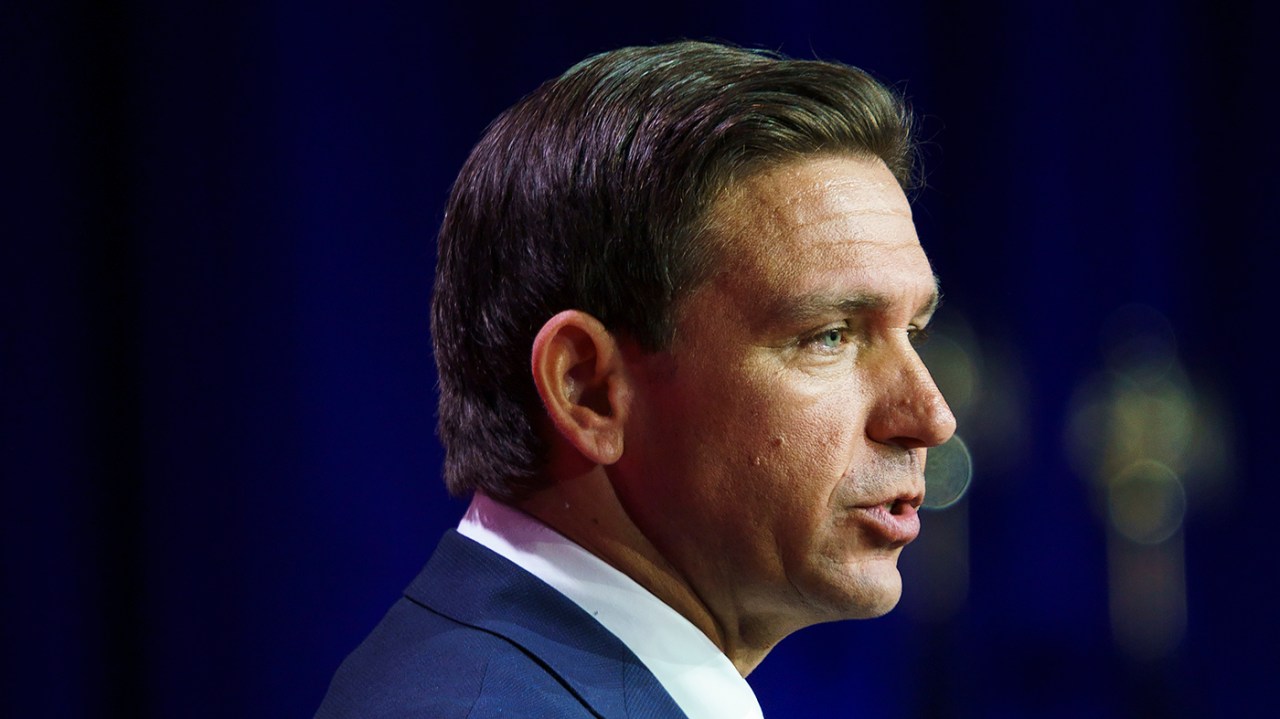
The Republican primaries, particularly those featuring Donald Trump and Ron DeSantis, are shaping a critical juncture for the party. The intense competition and the differing approaches of these candidates reflect deep divisions within the Republican electorate and raise questions about the party’s future direction. The outcome of these primaries will undoubtedly influence the party’s platform and its appeal to various segments of the population.The primary election results will have a cascading effect on the overall political landscape.
The choices made by Republican voters will not only impact the 2024 general election but also reverberate throughout the political spectrum, potentially shifting the balance of power in Congress and influencing policy debates.
Potential Impact on the Republican Party Platform
The candidates’ contrasting policy stances, from economic strategies to social issues, will likely influence the Republican Party platform. A victory by one candidate could solidify or reshape the party’s stance on issues like tax policy, immigration, and environmental regulations. The differing positions could lead to a more defined, potentially more polarized, platform, or, conversely, a more moderate approach to appease a wider range of voters.
Potential Consequences on the Political Landscape
The outcome of the primaries will significantly affect the political landscape, both nationally and internationally. The election’s result will impact the public perception of the Republican Party and its leaders. It will also influence foreign policy decisions and relations, given the potential for different candidates to adopt different approaches to international issues. The political discourse will likely become more focused on the issues prioritized by the winning candidate, potentially overshadowing other important considerations.
Implications for the 2024 General Election
The Republican primary results will be a significant factor in determining the party’s chances in the 2024 general election. A clear victory by one candidate will create a more cohesive and unified front, potentially increasing voter turnout and enthusiasm. Conversely, a contested outcome could lead to internal divisions and a decrease in voter confidence. The differing approaches to campaigning and voter outreach will likely affect the party’s ability to connect with various demographics.
Potential Voting Blocs and Candidate Support
The following table provides an illustrative view of potential voting blocs and their likely support for each candidate, keeping in mind that this is a simplified representation. Voter preferences are complex and dynamic, and specific results will depend on numerous factors.
| Voting Bloc | Likely Support (Trump) | Likely Support (DeSantis) | Likely Support (Other Candidates) |
|---|---|---|---|
| Base Voters | High | Moderate | Low |
| Moderate Republicans | Low | High | Low |
| Independents | Low | Moderate | High |
| Young Voters | Moderate | Moderate | High |
| Business Owners | High | Moderate | Low |
| Social Conservatives | High | Moderate | Low |
Media Coverage and Public Perception
The 2024 Republican primaries have been a crucible for media scrutiny and public opinion. The intense competition between Donald Trump and Ron DeSantis has resulted in a complex interplay of narratives, shaping the public’s understanding of each candidate and their platforms. The media’s role in this process, both in terms of coverage and presentation, is crucial in influencing public perception and ultimately, the outcome of the primaries.The media landscape has become increasingly polarized in recent years, and this polarization has significantly impacted the coverage of the 2024 Republican primaries.
This heightened scrutiny has often focused on specific policy stances and personal attributes of each candidate, leading to a potentially skewed public perception. Examining the media’s portrayal and the public’s reaction to each candidate is crucial to understanding the dynamics at play.
Patterns of Media Coverage
The media coverage of DeSantis and Trump has been characterized by distinct patterns. Trump, often a dominant figure in the news cycle, has seen extensive coverage focused on his past political achievements and controversies. This coverage often includes analysis of his pronouncements and actions, frequently drawing comparisons to his previous presidential campaigns. DeSantis, on the other hand, has been subject to a more detailed examination of his policy positions, particularly regarding his conservative stance on issues like education and immigration.
The media’s scrutiny of DeSantis’s approach to governing in Florida has also been a recurring theme.
The DeSantis-Trump Republican primaries are heating up, with candidates vying for the nomination. While the political maneuvering continues, it’s interesting to see how other seemingly unrelated events, like Arthur Smith being hired as the Steelers’ offensive coordinator ( arthur smith hired steelers offensive coordinator ), might subtly shift the narrative. This could all potentially influence the outcome of the primaries in unexpected ways.
Media Portrayal of Candidates
The media’s portrayal of each candidate often reflects the underlying narratives surrounding their campaigns. For Trump, the narrative frequently emphasizes his populist appeal, his strong base of support, and his often confrontational style. The media’s depiction of DeSantis often highlights his attempts to present a more traditional, moderate image, often contrasting it with Trump’s more controversial persona. This contrast has been a central theme in the coverage.
Public Perception of Candidates
Public perception of both candidates is influenced by various factors, including personal experiences, pre-existing political beliefs, and the specific narratives presented by the media. It’s crucial to acknowledge that public opinion is not monolithic and can vary significantly based on demographic factors and individual perspectives.
Perspectives from Different Media Outlets
| Media Outlet | Perspective on Trump | Perspective on DeSantis |
|---|---|---|
| News Network A | Focuses on Trump’s history, emphasizing his populist base and confrontational style. Highlights past controversies. | Presents DeSantis as a moderate alternative, emphasizing his policy positions and governing experience in Florida. |
| News Network B | Critiques Trump’s policies and rhetoric, emphasizing potential negative impacts on various sectors. | Examines DeSantis’s political strategy and potential vulnerabilities, focusing on areas where his policies may differ from the broader Republican base. |
| News Network C | Neutral, but often features articles comparing Trump’s and DeSantis’s approaches to policy issues. | Neutral, but often features articles comparing Trump’s and DeSantis’s approaches to policy issues. |
Policy Positions and Issues
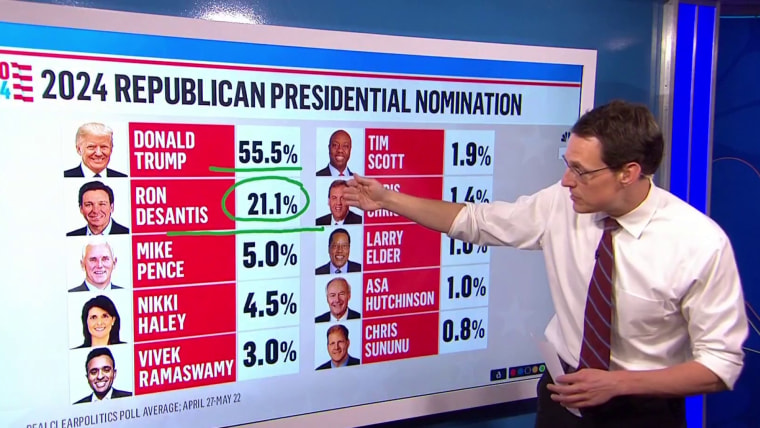
The Republican primary race in 2024 is marked by significant differences in policy positions, particularly regarding key issues like immigration, healthcare, and economic policies. Candidates like DeSantis and Trump, while sharing some core conservative principles, exhibit distinct approaches to these issues, which will likely shape the party’s platform and policy direction if either wins the nomination. Understanding these nuanced differences is crucial for analyzing the potential impact on various segments of the electorate.
Immigration Policies
The candidates’ stances on immigration are a key differentiator. Trump has consistently advocated for stricter border controls, including building a wall and more stringent enforcement measures. His proposals often emphasize national security concerns and the need to control illegal immigration. DeSantis, while sharing a general inclination toward stricter enforcement, has also explored alternative approaches, such as focusing on economic incentives and solutions in the source countries to reduce migration.
This difference highlights the multifaceted considerations surrounding immigration policy.
Healthcare Policies
The Republican candidates’ approaches to healthcare vary. Trump’s stance often leans toward repealing and replacing the Affordable Care Act (ACA), while supporting alternative market-based solutions. DeSantis, while expressing concern about the ACA’s structure, has also emphasized individual liberty and market-based approaches to healthcare, possibly suggesting a preference for solutions that prioritize individual choice and competition within the system.
Economic Policies
Economic policies are another critical area of divergence. Trump’s platform typically emphasizes tax cuts and deregulation, arguing that these measures stimulate economic growth. DeSantis’ approach also favors lower taxes and deregulation but also incorporates specific initiatives targeted at particular industries and sectors, which may reflect his interest in targeted economic growth and development.
| Candidate | Tax Cuts | Deregulation | Government Spending | Trade |
|---|---|---|---|---|
| Trump | Favors substantial tax cuts for corporations and individuals. | Advocates for broad deregulation across various sectors. | Generally, lower government spending. | Protectionist trade policies. |
| DeSantis | Supports tax cuts, but with potential focus on specific sectors or businesses. | Generally supports deregulation, potentially with targeted exceptions. | Focus on fiscal responsibility, but with some targeted spending initiatives. | Generally supports free trade but with some considerations for national interests. |
| Other Candidates | Varying levels of support for tax cuts, from moderate to aggressive. | Differing levels of support for deregulation across various sectors. | Differing views on the appropriate level of government spending. | Differing views on trade, ranging from protectionist to free trade. |
Social Justice and Civil Rights
The candidates’ approaches to social justice and civil rights issues are also diverse. Trump’s stance often focuses on law and order, emphasizing the need for a strong police presence and strict enforcement of existing laws. DeSantis, while generally supporting law and order, has also taken some positions that may be seen as more conservative, particularly in areas such as education and LGBTQ+ rights.
The varying approaches among the candidates reflect different interpretations of social justice and civil rights within the Republican party.
The DeSantis-Trump Republican primary battle is heating up, with a lot of speculation about the outcome. Meanwhile, the results of the New Hampshire Democratic primary, which you can find here , are offering a glimpse into the current political landscape. These early primary results could potentially shift the dynamics within the Republican field as we head toward the crucial primaries ahead.
The overall impact on the DeSantis-Trump rivalry remains to be seen, but the political climate is definitely getting more intense.
Campaign Strategies and Messaging
The Republican primaries are a crucible where candidates refine their approaches to appeal to the party base. Strategies vary widely, reflecting the diverse viewpoints within the party and the different paths each candidate believes will lead to victory. Candidates must navigate complex issues and craft compelling narratives to win over voters, a task that often requires adaptation and adjustments throughout the campaign.Understanding the nuances of each candidate’s approach to messaging is crucial to grasping the dynamics of the primary race.
This includes analyzing how they tailor their arguments to different segments of the electorate, from core supporters to potential swing voters. The effectiveness of these strategies will be a key factor in determining the outcome of the primaries and shaping the trajectory of the 2024 election.
DeSantis’s Campaign Strategy
DeSantis, known for his relatively moderate stance on some issues, often emphasizes fiscal conservatism, cultural values, and a strong national defense. His campaign often highlights his experience as a governor and presents him as a capable and decisive leader. He attempts to position himself as a viable alternative to Trump, appealing to a more pragmatic and moderate segment of the electorate while still retaining conservative voters.
His campaign’s messaging frequently touches upon economic growth, law and order, and a return to traditional American values.
Trump’s Campaign Strategy
Trump’s campaign, in contrast, relies heavily on a populist approach. His messaging often centers around the theme of “making America great again,” emphasizing economic nationalism and an unwavering stance against perceived enemies. He frequently employs emotionally charged language and rallies to energize his base. His campaign strategies often revolve around stirring controversy and emphasizing his status as a successful businessman and former president.
Comparison of Candidate Strategies
| Candidate | Core Messaging | Target Demographics | Campaign Style |
|---|---|---|---|
| DeSantis | Experienced, moderate conservative; economic growth, law and order, traditional values. | Moderates, some swing voters, traditional conservatives | Professional, less confrontational. |
| Trump | Populist; economic nationalism, anti-establishment, strong America. | Core conservatives, populist voters, those who support his past policies. | Energetic, confrontational, rallies. |
| Other Candidates | Varying approaches, often focused on specific policy issues or segments of the electorate. | Specific voter bases, such as fiscal conservatives, social conservatives, etc. | Various styles; some emphasizing specific policy platforms. |
Messaging Strategies and Voter Demographics
Candidates often tailor their messaging to resonate with specific demographic groups. For example, Trump’s focus on economic issues and protectionist policies resonates strongly with working-class voters and those concerned about job losses. DeSantis, in contrast, may appeal more to suburban voters who are concerned about issues like crime and education. Other candidates may concentrate on specific policy areas or values, like social issues or fiscal responsibility.
This targeted approach is a key element in their strategies. The effectiveness of these strategies will be measured by their ability to mobilize support and sway the electorate.
Voter Turnout and Demographics
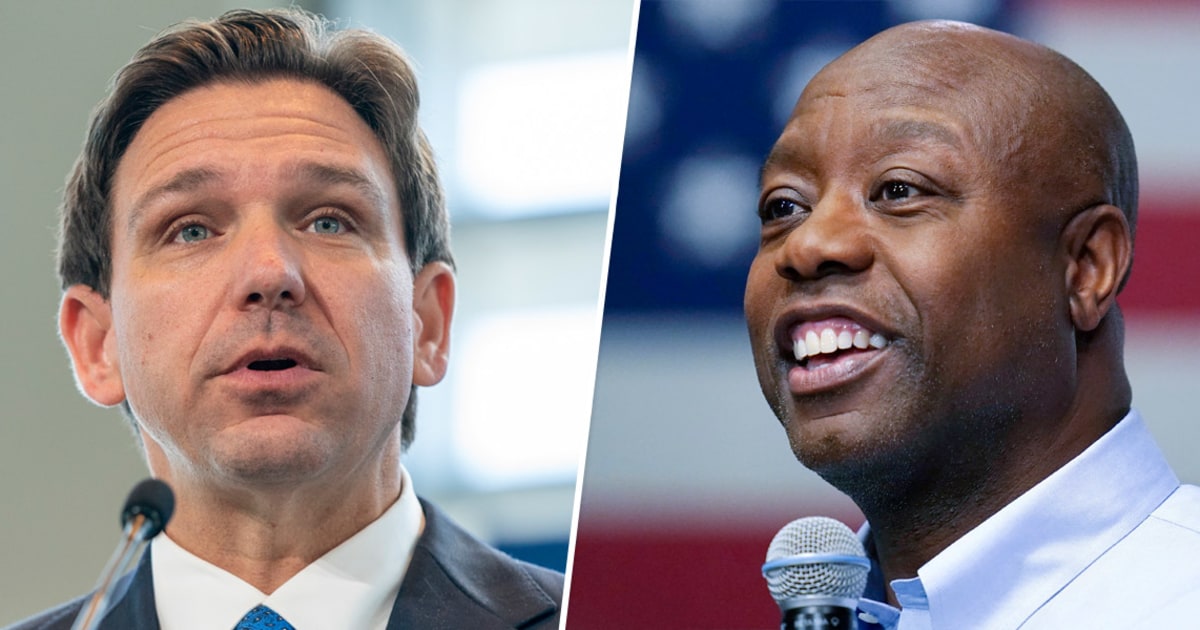
Predicting voter turnout and demographics in Republican primaries is a complex undertaking, influenced by various factors, including candidate appeal, perceived policy positions, and broader political trends. Analyzing past election data and current political climate offers insights into potential patterns, but the unpredictability of individual voter choices remains a significant element. The motivations behind different voting decisions are multifaceted and cannot be fully captured in a single analysis.
This section will delve into potential voter turnout, explore demographic predictions, and examine the reasons behind the support for each candidate.
Potential Voter Turnout
The potential voter turnout in Republican primaries will likely be influenced by the level of interest in the candidates and the overall political climate. High-profile contests with strong candidate engagement tend to attract a larger electorate. Historical data on Republican primary turnout in similar situations provides a foundation for estimating potential participation. For instance, high-stakes primaries during periods of significant political division often see higher turnout than during less polarized times.
Voter Demographics for Each Candidate
The demographic makeup of voters supporting each candidate is a key factor in understanding the underlying motivations and strategic approaches. Examining the historical voting patterns of various demographic groups within the Republican party can help in predicting their likely support. For example, rural voters have historically favored candidates with strong conservative stances, while suburban voters might be more responsive to candidates emphasizing economic issues.
Motivations Behind Voter Choices
Voters’ choices in Republican primaries are often driven by a combination of factors, including ideological alignment, candidate personality, and perceived policy effectiveness. Economic concerns, social issues, and foreign policy positions can also play a significant role. The interplay of these factors varies among different demographic groups, influencing the ultimate outcome. Understanding these motivations requires a nuanced analysis of each candidate’s appeal within specific segments of the electorate.
Demographic Groups Supporting Each Candidate
Certain demographic groups are more likely to support specific candidates based on shared values and beliefs. For instance, those with strong religious affiliations may be drawn to candidates who emphasize religious values, while voters concerned about economic stability might gravitate towards candidates with pro-business platforms. Candidates’ public statements and campaign messaging also play a crucial role in shaping voter perceptions and attracting support.
This requires careful analysis of the candidate’s platform, public appearances, and the media coverage.
Potential Voter Turnout by State and Demographics
| State | Estimated Turnout | Likely Demographics | Motivations |
|---|---|---|---|
| Iowa | High | Rural voters, evangelical Christians, and conservatives | Strong ideological alignment, traditional values |
| New Hampshire | Medium | Suburban voters, moderate Republicans, and independent voters | Focus on specific policy issues, candidate personality |
| South Carolina | High | Conservative voters, African Americans, and evangelical Christians | Candidate appeal, strong social issues stances |
Note: This table provides a hypothetical representation. Actual turnout and demographics will depend on various factors, including candidate performance and the overall political environment.
Historical Context of Republican Primaries
The Republican primaries, a crucial stage in the party’s presidential nominating process, have a rich history, shaping the party’s trajectory and influencing the eventual nominee’s platform. Understanding this history provides valuable context for analyzing the current race and predicting potential outcomes. Examining past election cycles and their results offers insight into recurring patterns and emerging trends.The historical landscape of Republican primaries reveals a dynamic interplay of factors, including ideological shifts within the party, the impact of significant events, and the evolving strategies of candidates.
The DeSantis-Trump Republican primaries are heating up, with a lot of maneuvering and back-and-forth. Meanwhile, the recent news about Chris Young’s charges being dropped, here , might just be a small piece of the larger political puzzle. It certainly adds an interesting layer to the already complex dynamics surrounding the primaries, suggesting some surprising alliances or shifting political winds.
This analysis will delve into past election cycles, comparing and contrasting them with the current primaries to highlight similarities and differences, and examining the historical trends and patterns of support for candidates.
Past Election Cycles and Outcomes
Examining past Republican primary elections provides a valuable framework for understanding the current contest. The 2016 primary, for example, saw a highly contested race between Donald Trump and various other candidates. The 2012 primary featured a significant primary battle between Mitt Romney and Rick Santorum. These examples demonstrate the variability and unpredictability inherent in Republican primaries. The outcome of these past elections was profoundly affected by factors such as candidate charisma, public perception, and the prevailing political climate.
Comparison of Current Primaries with Past Ones
The current Republican primaries, featuring DeSantis and Trump, bear certain similarities and significant differences compared to past cycles. Similarities include the intense focus on policy positions and the importance of media coverage. However, differences lie in the prominent role of social media, the amplified influence of particular interest groups, and the overall level of public discourse.
Historical Trends and Patterns of Support
Analyzing historical trends reveals recurring patterns of support for candidates in Republican primaries. For instance, a strong emphasis on conservative values and economic issues consistently appears as a key driver of voter choices. Candidates who effectively communicate their stance on these issues tend to garner significant support. The role of party establishment figures and their endorsements also frequently plays a substantial role.
Table of Historical Election Results
| Year | Nominee | Key Contenders | Significant Events/Trends |
|---|---|---|---|
| 2016 | Donald Trump | Ted Cruz, Marco Rubio | Unprecedented level of media attention; populist appeal of Trump |
| 2012 | Mitt Romney | Rick Santorum, Newt Gingrich | Economic concerns played a major role; rise of social media |
| 2008 | John McCain | Mitt Romney, Mike Huckabee | The impact of the financial crisis; increasing polarization |
| 2000 | George W. Bush | John McCain, Steve Forbes | Focus on domestic issues; the rise of the conservative movement |
This table provides a snapshot of historical election results, highlighting key trends and comparisons between different election cycles.
Ultimate Conclusion
In conclusion, the DeSantis-Trump Republican primaries are a significant event with potential ripple effects across the political spectrum. The outcome will not only determine the Republican nominee but also influence the party’s platform, its approach to key issues, and the overall political landscape heading into the 2024 general election. The clash of ideologies and campaign strategies promises to be a fascinating and highly-watched spectacle.
FAQ Insights: Desantis Trump Republicans Primaries
Q: What are the key policy differences between DeSantis and Trump?
A: While both candidates share some conservative principles, differences exist in their approaches to issues like immigration, economic policy, and social issues. Further analysis of their specific policy positions would illuminate these differences.
Q: How will the media coverage impact public perception of the candidates?
A: Media portrayal can significantly influence public opinion. The narratives surrounding the campaigns, and the way the candidates are framed by different outlets, will likely sway voter perceptions and shape the narrative surrounding the race.
Q: What are the potential consequences of the primary election results on the Republican Party?
A: The outcome could shift the party’s direction, influencing its platform and its approach to key issues. The chosen nominee will set the tone for the general election and potentially influence the party’s direction for years to come.
Q: What are the historical precedents for Republican primaries?
A: Examining past Republican primary elections can offer valuable insights into potential outcomes and trends. Understanding historical context allows for a more comprehensive understanding of the current political landscape.



